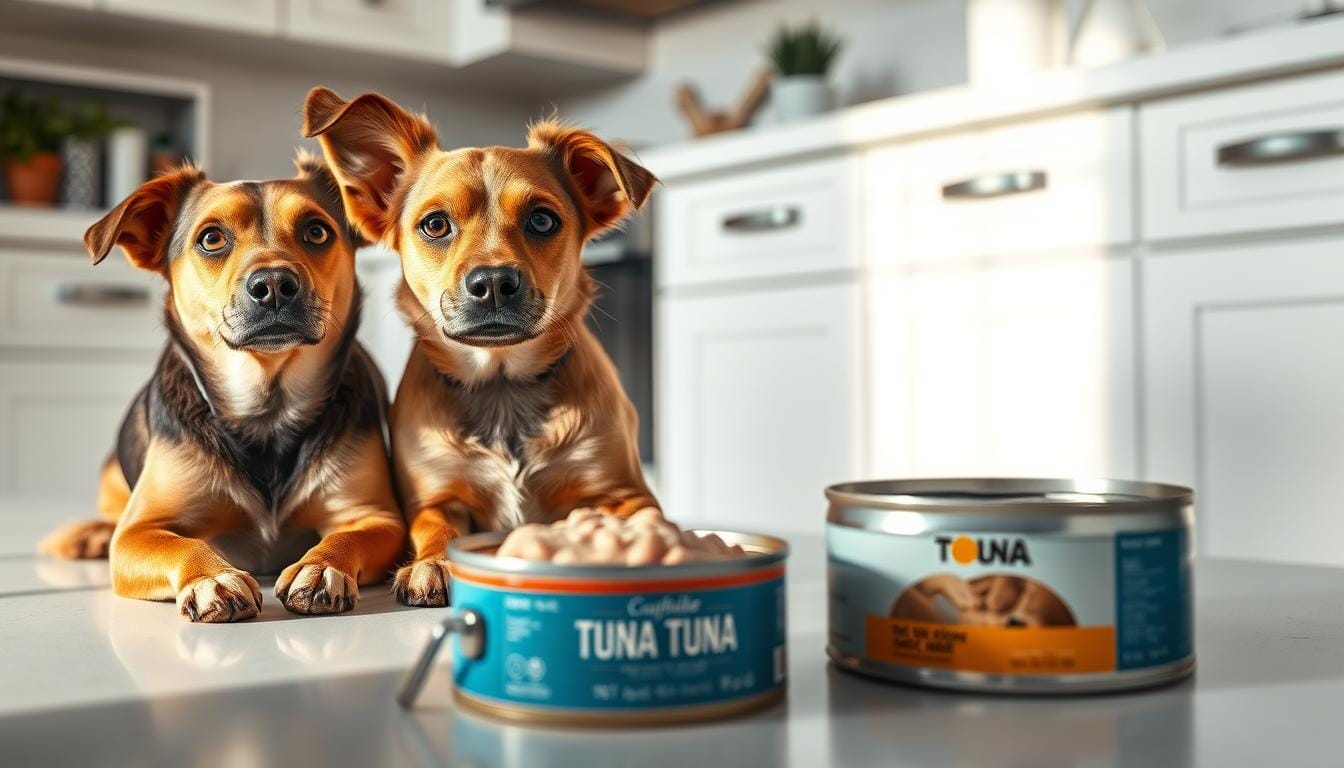As a devoted dog parent, you’ve probably wondered about sharing some of your favorite human foods with your furry companion. Canned tuna, with its enticing aroma, often catches your dog’s attention. This makes you curious about dog nutrition and safe human foods for dogs.
Table of Contents
Understanding whether dogs can eat canned tuna requires careful consideration. While tuna might seem like a protein-rich treat, it’s not as straightforward as you might think. The potential risks associated with tuna consumption in dogs are significant and demand a closer look.
Your dog’s health is paramount, and knowing the details about can dogs eat canned tuna can help you make informed dietary choices. This guide will explore the complexities of feeding tuna to your canine friend. We’ll ensure you have all the necessary information to keep them safe and healthy.
Key Takeaways
- Tuna contains high mercury levels potentially harmful to dogs
- Small amounts might not cause immediate harm
- Safer fish alternatives exist for dog nutrition
- Consultation with a veterinarian is recommended
- Monitoring your dog after consuming tuna is crucial
Understanding Tuna Consumption for Dogs
Feeding canned tuna to dogs needs careful thought. It’s important to consider their special dietary needs. Tuna can add protein to their diet if done right.
Types of Tuna for Canine Consumption
Dogs can eat tuna in different ways. Each type has its own features:
- Canned tuna in water – The best choice for dogs
- Fresh tuna steaks
- Tuna packed in oil
Nutritional Profile of Tuna
Tuna offers many benefits for dogs, including:
- High-quality protein
- Omega-3 fatty acids
- Essential minerals like selenium
- Vitamin D
Tuna Preparation Methods
Preparation is key when it comes to tuna and dogs. Raw tuna can be risky. Cooked or canned tuna is safer. Always pick plain tuna without salt or seasonings for your dog’s health.
Remember: Moderation is key when introducing any new food to your dog’s diet.
The nutritional value of tuna can change a lot. It’s vital to know the best types for your dog’s diet.
Health Benefits of Tuna for Dogs
Tuna is a nutritional powerhouse for your furry friend. It’s packed with essential nutrients that support your dog’s health. This makes tuna a great addition to your dog’s diet.
The protein in tuna is a big plus for your dog’s nutrition. It helps keep your dog’s muscles strong and active. Here are some key benefits:
- Rich source of lean protein for muscle development
- Omega-3 fatty acids that promote healthy skin and coat
- Essential minerals supporting cardiovascular health
- Vitamin B12 for energy metabolism
Is tuna fish good for dogs? Yes, it can be a great treat when given in small amounts. The omega-3 fatty acids in tuna help reduce inflammation and support joint health. These nutrients also make your dog’s coat shiny and boost their immune system.
“Nutrition is the foundation of good health for dogs, and tuna can be a valuable addition when served responsibly.” – Veterinary Nutrition Expert
While tuna has many health benefits, it should not be a main part of your dog’s diet. Always talk to your vet about how much tuna your dog can have.
Can Dogs Eat Canned Tuna: Safety Guidelines
When it comes to canned tuna for dogs, you need to be careful. Tuna is a good source of protein, but knowing the right way to feed it is important for your dog’s health.
Vets say to be careful with tuna for dogs. Not every dog will react the same way. So, it’s important to check how your dog does with it.
Proper Serving Sizes
Finding the right amount of tuna for your dog depends on a few things:
- Dog’s body weight
- Overall health condition
- Age and activity level
A good starting point is to give small amounts. Small dogs might get 1-2 teaspoons, while bigger dogs could have 1-2 tablespoons.
Frequency of Feeding
Tuna shouldn’t be a regular part of your dog’s diet. Vets recommend:
- Only give tuna as an occasional treat
- Wait at least 1-2 weeks before giving it again
- Mix it up with other protein sources
Signs of Adverse Reactions
Be on the lookout for bad reactions to tuna. Look for:
- Digestive upset
- Vomiting
- Diarrhea
- Unusual lethargy
Always talk to your vet before changing your dog’s diet.
Being careful with tuna is key. Every dog is different. So, getting advice from a vet is the best way to add tuna to your dog’s meals.
Mercury Levels in Tuna: What Dog Owners Should Know
When thinking about can dogs eat canned tuna, knowing about mercury is key. Tuna has a lot of mercury, which can hurt your dog’s health.
Mercury builds up in tuna because of a process called bioaccumulation. Bigger tuna eat smaller fish with mercury. This makes tuna risky for dogs, even a little bit.
- Bigeye tuna contains 0.689 ppm of mercury
- Salmon has much lower mercury levels at 0.022 ppm
- Light canned tuna averages 0.126 ppm mercury
- Albacore tuna reaches 0.350 ppm mercury
Potential mercury poisoning symptoms in dogs include:
- Hair loss
- Anxiety
- Blindness
- Kidney damage
- Loss of coordination
- Tremors
- Gastrointestinal issues
Vets say to avoid tuna. Instead, pick safer fish with less mercury for your dog’s diet.
| Fish Type | Mercury Level (ppm) | Dog Safety |
|---|---|---|
| Bigeye Tuna | 0.689 | High Risk |
| Albacore Tuna | 0.350 | High Risk |
| Salmon | 0.022 | Safe Option |
| Herring | 0.035 | Safe Option |
Protecting your dog’s health means making informed dietary choices. Always check with your vet for the best fish for your pet’s diet.
Choosing the Right Type of Canned Tuna
Feeding canned tuna to dogs needs careful thought. Not all canned tuna is good for pets. Knowing the differences helps choose the best for your dog.
- Always opt for water-packed tuna
- Avoid oil-packed varieties
- Check sodium content carefully
- Skip flavored or seasoned options
Water-Packed vs. Oil-Packed Tuna
Water-packed tuna is safer for dogs. Oil-packed tuna has too much fat. This can upset your dog’s stomach and even cause pancreatitis.
Your dog’s digestive system handles water-packed tuna much more efficiently.
“Clean, simple nutrition is always best for your canine companion.” – Veterinary Nutrition Expert
Salt Content Considerations
Sodium levels matter when giving canned tuna to dogs. Too much salt can be very harmful. It can raise blood pressure, strain the kidneys, and even poison your dog.
Choose low-sodium or no-salt-added tuna. Always rinse the tuna before serving to cut down on salt.
Potential Risks of Feeding Tuna to Dogs
Experts say there are big risks when dogs eat canned tuna. Tuna is rich in protein, but it’s important to know the dangers. This is crucial for your dog’s health.
Mercury is a big threat to your dog’s health. Tuna, mainly big species, has a lot of mercury. This can harm your dog’s brain and nervous system if eaten too often.
- Mercury poisoning symptoms include muscle weakness
- Potential neurological damage
- Digestive system disruptions
- Potential kidney complications
It’s important to balance your dog’s diet. Eating too much tuna can upset their nutrition. The high sodium in some tuna can also harm their metabolism.
| Risk Factor | Potential Impact | Severity |
|---|---|---|
| Mercury Levels | Neurological Damage | High |
| Sodium Content | Kidney Stress | Medium |
| Nutritional Imbalance | Metabolic Disruption | Low-Medium |
There are also choking risks from small bones and allergic reactions. Always talk to your vet before adding tuna to your dog’s diet.
Best Practices for Serving Canned Tuna to Dogs
Feeding canned tuna to dogs needs careful thought and the right preparation. Knowing how to introduce this safe food can greatly benefit your dog’s health and nutrition.
Preparation Methods for Dog-Friendly Tuna
Getting tuna ready for your dog is key. Here are important steps for safe feeding:
- Select water-packed tuna without added salt
- Drain excess liquid completely
- Check thoroughly for small bones
- Serve in small, controlled portions
Storage Guidelines for Canned Tuna
Keeping tuna safe is crucial when storing it for your dog. Follow these storage tips:
- Transfer unused tuna to an airtight container
- Refrigerate immediately after opening
- Consume within 1-2 days
- Check for spoilage before serving
There are fun ways to serve tuna safely, like as a topping or in homemade treats. But remember, it’s important to keep portions small. Tuna should not be the main part of your dog’s diet.
Always talk to your vet before adding new foods. This ensures they’re right for your dog’s health.
Alternatives to Canned Tuna for Dogs
Looking for dog-friendly foods? There are great options beyond canned tuna. These alternatives can be healthier and safer for your pet. Dogs have different needs, and many protein sources can help keep them healthy.
- Salmon: Full of omega-3 fatty acids
- Boosts brain function
- Reduces inflammation
- One 3-ounce serving has 586 mg EPA and 145 mg DHA
- Cod: Great for dogs needing low-fat options
- Has fewer calories
- Contains 18 mg EPA per 3-ounce serving
- Good for weight control
- Sardines: Safe from mercury
- Has low mercury levels
- 228 mg EPA per 4 small sardines
- Easy to add to their diet
If dogs can’t eat fish, plant-based omega-3s are good substitutes:
- Flaxseeds: Rich in anti-inflammatory ALA
- Helps keep their coat healthy
- Improves digestion
- Chia seeds: A nutritional powerhouse
- Boosts their immune system
- Improves skin and coat health
- High in fiber and antioxidants
Always introduce new foods slowly. Talk to your vet to make sure it’s right for your dog.
Special Considerations for Puppies and Senior Dogs

Understanding the dietary needs of puppies and senior dogs is key. This is true, even when it comes to canned tuna. These age groups need special care to stay healthy.
Puppies are at high risk from tuna due to mercury poisoning. Experts say young dogs should not have tuna at all. This is because their bodies are still growing and can’t handle toxins well.
- Puppies have smaller body masses
- Higher sensitivity to toxins
- Developing immune and nervous systems
Senior dogs have different needs. While they might need protein, tuna is not always safe. Their bodies might not handle mercury as well as younger dogs.
Here are some tips for puppies and senior dogs:
- Always talk to your vet before trying new foods
- Don’t give tuna to puppies
- Limit tuna for older dogs
- Watch for any bad reactions
The dangers of mercury are too great. Choose safer proteins that fit your dog’s age and needs. This is the best way to keep them healthy for a long time.
Signs of Tuna-Related Health Issues in Dogs
Pet health is key when adding new foods like canned tuna fish to your dog’s diet. Tuna can be a good protein source, but it’s important to know the risks and warning signs of bad reactions.
When wondering if tuna is safe for dogs, pet owners need to watch for health problems that can come from eating this fish.
Mercury Poisoning Symptoms to Watch
Mercury poisoning is a big worry for dogs that eat tuna. Keep an eye out for these important signs:
- Tremors or muscle weakness
- Coordination difficulties
- Sudden vision problems
- Unexplained anxiety or behavioral changes
- Digestive issues like vomiting or diarrhea
When to Seek Veterinary Care
If your dog shows any of these symptoms after eating canned tuna fish, call your vet right away:
- Persistent vomiting or diarrhea
- Significant changes in behavior
- Neurological symptoms like loss of balance
- Extreme lethargy or weakness
Early detection and professional medical help are crucial for managing tuna-related health issues in dogs.
Remember: Your dog’s health should always be the top priority when introducing new foods to their diet.
Integrating Tuna into Your Dog’s Diet Plan
Feeding canned tuna to dogs needs careful thought. Tuna can be a good treat if done right. But, it should never be the main food for your dog.
Here are key tips for adding tuna to your dog’s diet:
- Limit tuna to occasional treats
- Ensure treats comprise no more than 10% of daily caloric intake
- Choose plain, water-packed tuna without added salt
- Remove all bones before serving
Dog nutrition experts say to introduce tuna slowly. Start with small amounts and watch how your dog reacts. Look out for signs of allergies or stomach problems.
| Tuna Serving Guidelines | Recommended Approach |
|---|---|
| Portion Size | 1-2 teaspoons per 20 pounds of body weight |
| Frequency | Once or twice monthly |
| Preparation | Plain, cooked, bone-free |
Always talk to your vet before changing your dog’s diet. They can give advice that fits your dog’s health and needs.
Raw vs. Cooked Tuna: Safety Comparison

When thinking about can dogs eat canned tuna, it’s important to know the difference between raw and cooked tuna. Raw fish can be risky for dogs. Dog owners need to think carefully before giving it to their pets.
Raw tuna can be harmful to dogs. It might have parasites and bacteria that can make them very sick. It’s important to prepare safe human foods for dogs to avoid these risks.
- Raw tuna may harbor parasitic worms
- Uncooked fish can contain dangerous bacteria
- Cooking eliminates most health risks
Tuna and dogs have a tricky relationship when it comes to eating it. Cooked or canned tuna is safer than raw fish. Cooking kills harmful germs, making it better for dogs.
| Tuna Preparation | Safety Level | Recommended for Dogs |
|---|---|---|
| Raw Tuna | High Risk | Not Recommended |
| Cooked Tuna | Low Risk | Moderate Consumption |
| Canned Tuna (Water-Packed) | Low Risk | Occasional Treat |
Pet owners should pick cooked or canned tuna for their dogs. Choose water-packed varieties without salt or seasonings. Remember, a little bit is okay to keep your dog safe and healthy.
Conclusion
When thinking about if dogs can eat canned tuna, pet owners need to be careful. Dog nutrition is key in deciding if tuna is good for your dog. It’s important to do research and get advice from experts before adding tuna to your dog’s diet.
Keeping your pet’s health in mind is crucial when choosing their food. Canned tuna has good stuff like protein and omega-3s. But, it’s important to give it in small amounts and without salt or seasonings.
It’s a good idea to talk to a vet before changing your dog’s diet. Your dog’s health, age, and any health issues can affect how they handle tuna. Being careful and informed helps you make choices that keep your dog happy and healthy.
Even though tuna can be a treat, a balanced diet is more important. Making sure your dog gets the right food shows you care about their health. This is what being a responsible dog owner is all about.

